Time to mine some gemstones—but be careful not to wake the dragon!
What Is Hammer Time?
Hammer Time is a dexterity game for 2 to 4 players, ages 5 and up, and takes about 15 minutes to play. It retails for $24.99 and is available in stores now or directly from HABA USA. I think the game could be played by any kid who knows not to swallow the gems, though it does require some fine motor skills.
Hammer Time was designed by Shaun Graham and Scott Huntington and published by HABA, with illustrations by Natalie Behle.

Hammer Time Components
Here’s what comes in the box:
- Hammer
- 90 Gemstones (16 each in blue, green, yellow, red, black; 10 clear)
- Wooden die
- First Player card
- 9 Task cards
- 16 Wagon cards (4 each in 4 colors)
- Playmat sticker
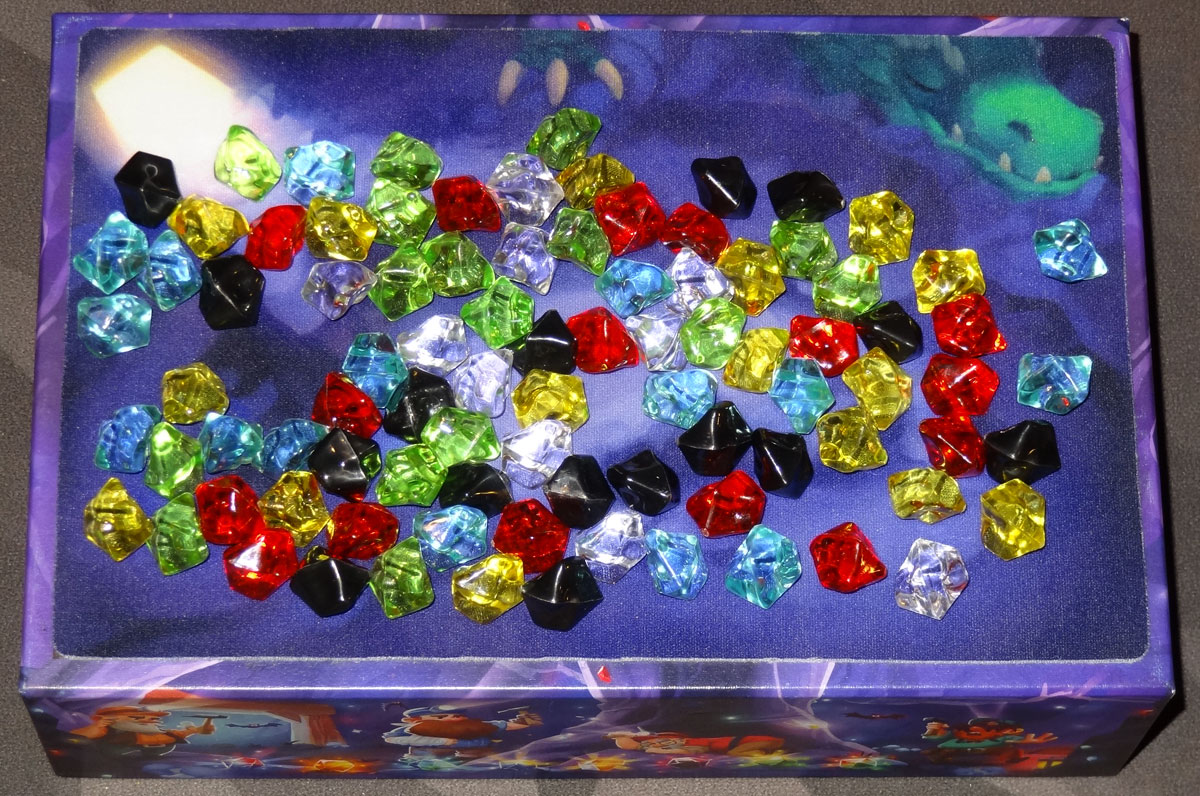
The playmat sticker is a thin neoprene mat, illustrated to look like the inside of a cave with a sleeping dragon’s head visible in the corner. Before the first game, you stick it to the bottom of the box, making it one of the gameplay components. I noticed that the sticker shifted around a bit, and actually peels off without too much difficulty—possibly due to the extreme heat we had recently?—but it’s intended to be stuck permanently. It does feel a little strange, having a playmat on the exterior of the box (and not being able to see the box back info), but the mat’s necessary to keep the gems from sliding too much.
The gemstones themselves are a standard small plastic gem. The black gemstones are opaque, but the rest are transparent. The hammer is made of wood, and is sized for kid hands, though it’s not too small for adults.
The rulebook comes in six different languages, but the game itself is language independent. The die just has colored spots on it, and the illustrations on the side of the box bottom depict gnomes wearing different colors acting out the various rules. The task cards are small-sized cards and they don’t have any text on them (though some have numbers)—instead, the tasks are all represented with illustrations as well. The first time you play you’ll need to read the rulebook to see what everything means, but once everyone has learned the illustrations, there’s no reading involved.

One neat feature is also helpful for kids who haven’t learned to count yet: there’s a threshold of 8 gems in the game, and on the sides of the box bottom there are gems illustrated along the edge—kids can match up the gemstones to the drawing, and if they have any leftover gems, they’ve gotten too many. It’s a nice touch that allows younger kids to play on their own even without an adult’s help, or to practice their number sense.

The cards are a stiff cardstock, almost more like a thin cardboard than playing cards, but they don’t require a whole lot of shuffling so it’s okay, though I don’t especially like the feel of them.
How to Play Hammer Time
You can download a copy of the rulebook here. (The rulebook is in multiple languages, so you’ll need to scroll down if you can’t read German.)
The Goal
The goal of the game is to be the first to fill all four of your wagon cards.
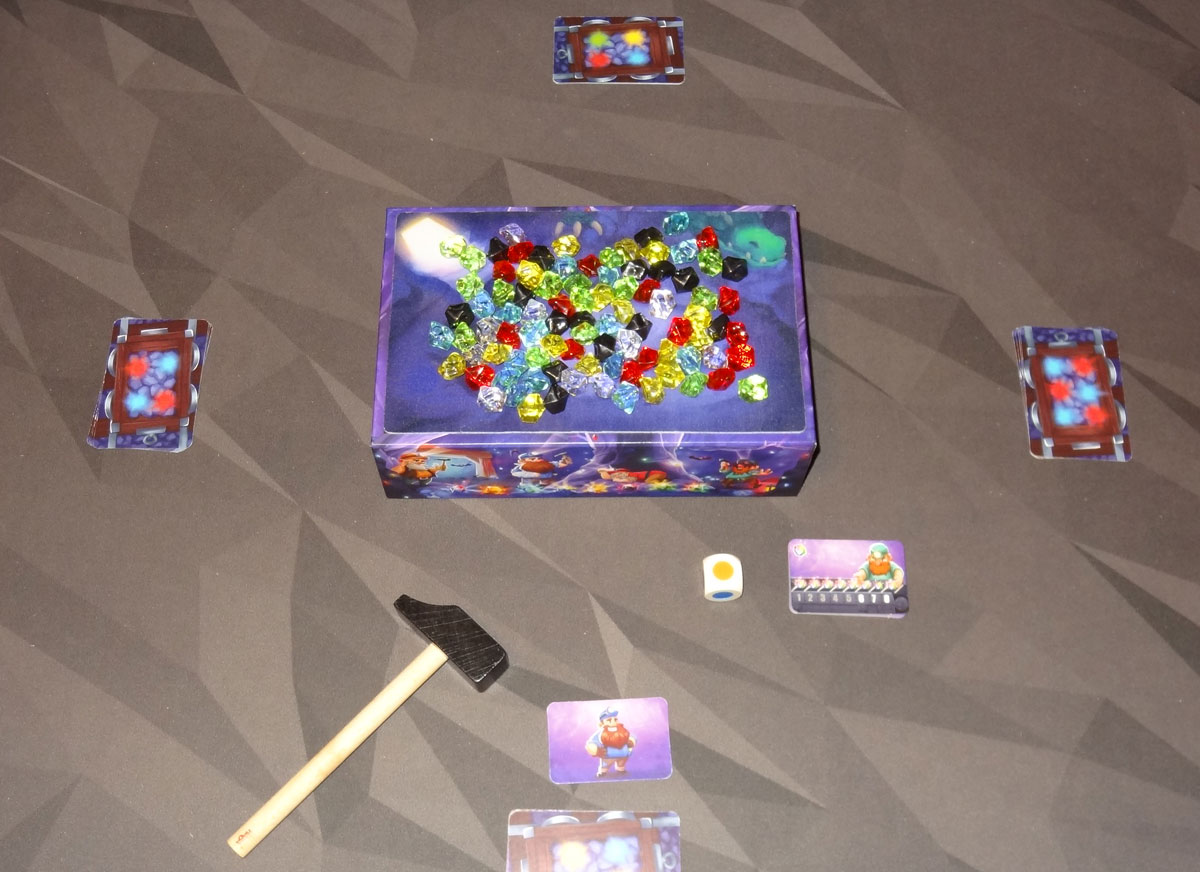
Setup
Give each player a set of four wagon cards in the same color. Each player should shuffle their cards and then flip the stack over, so the gems are visible in the top card. Shuffle the task cards and set them in a stack so the top card is face-up, and give the starting player card to the youngest player.
Dump all of the gems onto the box base. The wooden die is used for the optional advanced variant, but can be set aside otherwise.
Gameplay
On your turn, you tap the box base with the handle until at least 1 gemstone falls off, and then you stop.
If you have more than 8 gems, the dragon wakes up and you get none of them: put them all back onto the box.
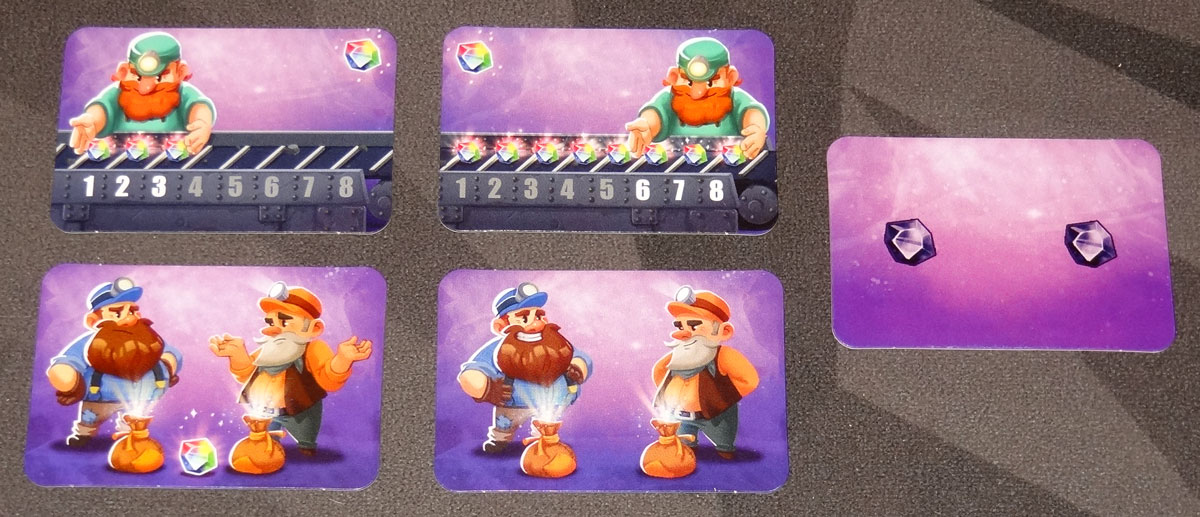
Otherwise, check if you’ve completed the top task card based on what you’ve knocked off the box. If so, take the card and flip it over to the clear gem side. The various tasks include:
- 1–3 gems
- 6–8 gems
- an odd number of gems
- an even number of gems
- 2 black gems
Finally, collect any gems that match your wagon and place them on your wagon card. Clear gems are wild and count as any color (and may be moved around in your wagon as needed). Each completed task card also counts as one clear gem. Any remaining gems are placed back onto the box.
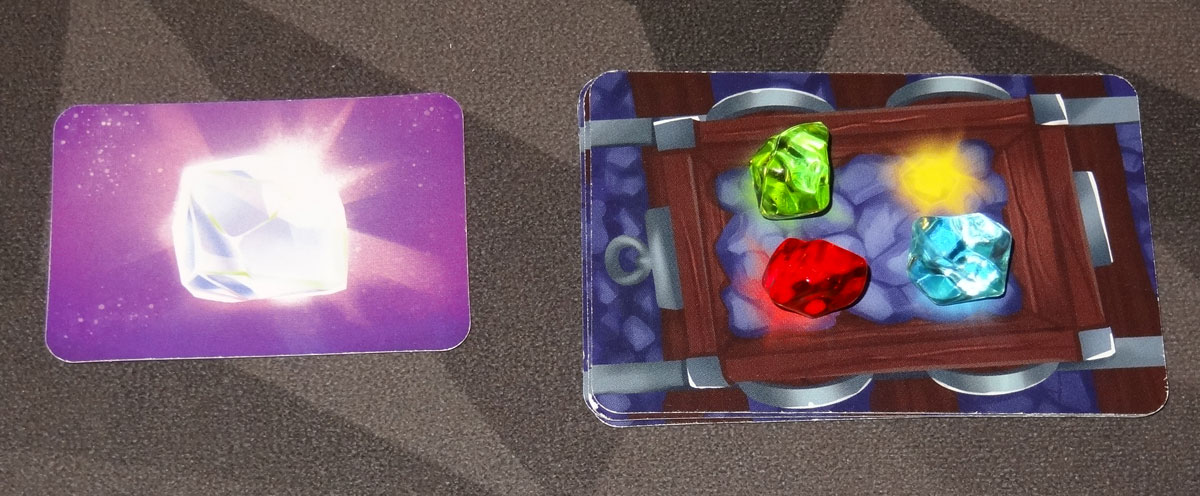
If you have enough gems to fill your wagon, return those gems to the box and flip your wagon card over, revealing the next card. (If you use any task cards as gems, return those cards to the bottom of the task deck.)
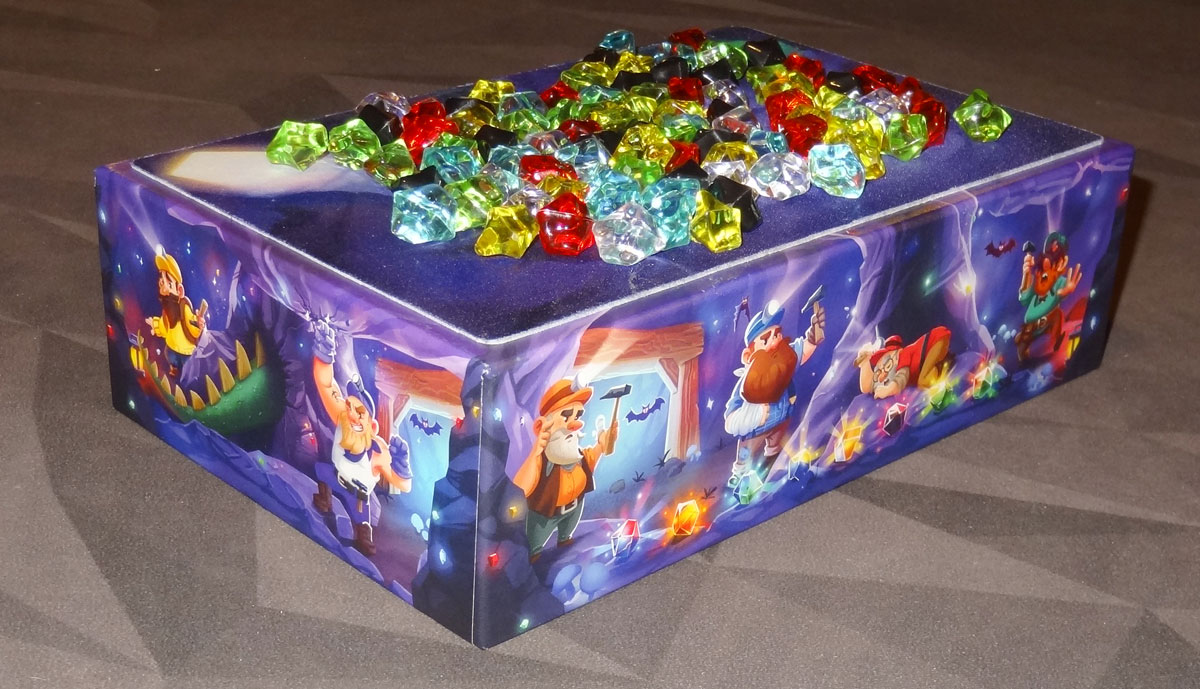
In the advanced variant, players must roll the die at the beginning of their turn, and it affects how they hit the box:
- Yellow: hit the box with the hammer handle instead
- Purple: hit the box with your fist instead of the hammer
- Orange: your thumb may not touch the hammer
- Blue: use your non-dominant hand for the hammer
- Red: lay your head sideways on the table while knocking
- Green: you must knock with your eyes closed.
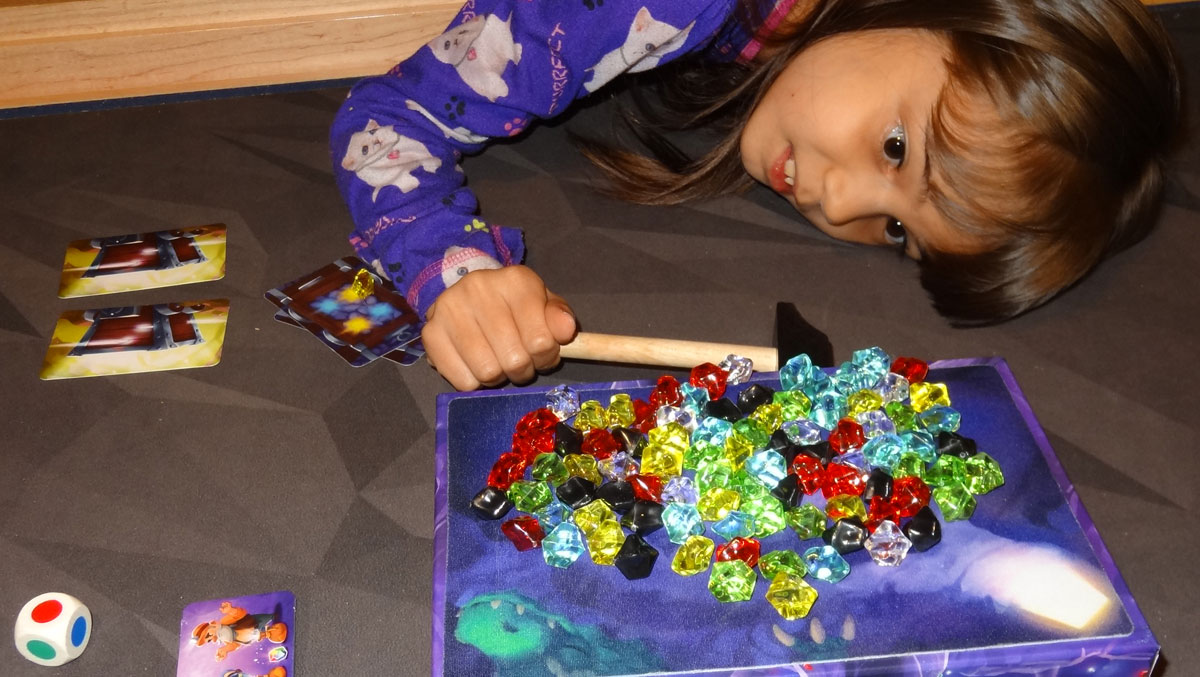
Game End
When a player fills their last wagon, the end of the game is triggered. Continue playing the round until everyone has had the same number of turns. If only one player has filled all four wagons, they win! If multiple players have filled all four wagons, ties are broken by the number of remaining task cards they have.
Why You Should Play Hammer Time
Dexterity games can be hit or miss, depending on the gaming group, but I always enjoy seeing the zany concepts. There are a few types that are more common, like balancing and flicking, and then things that are a little more unusual, like throwing cards or rolling things. Hammer Time is tricky to categorize, because it does involve things falling down, but it’s not really about balancing—I’d probably put it in the general “hitting things” category.

What sets Hammer Time apart is the fact that you’re hitting the box base so that the gems on top will fall off, so you’re relying on inertia. In theory, the box goes one way while the gems stay put, so you can tap gently to shift the whole mass of gems in one direction or another. We did find, though, that once a gem gets off the edge of the playmat, there’s no way to knock it back on, which can create some very tricky situations where you know that gem will likely fall off no matter what direction you tap.
Hammer Time is designed for kids and is definitely kid-friendly, but that doesn’t mean that adults won’t get a kick out of it, or that you can’t think strategically (at least to some extent). You’re trying to collect specific colors of gems, and sometimes there just aren’t any of that color near the edges of the pile. In that case, going for the tasks may be your only hope, but that seems to be more random: can you really control whether you get an odd or even number of gems? (And for the task that requires 2 black gems, you’re again relying on whether there even are 2 black gems near each other on an edge.) The other thing you can consider is what the other players want, because if you can’t get anything for your own wagon, at least you don’t want to set somebody up to fill theirs.
The 8-gem max is a good limit: it means that you have to strike a balance between getting a lot of gems, the better to get the colors you need, and hitting the box too hard and getting nothing at all. It can take some practice to get the strength just right, and the surface you’re playing on will also make a big difference. The box will slide more on a hard table than on a playmat. I wondered whether the box was going to get totally dinged up, but so far it’s looking fine—I think if you’re hitting it hard enough to dent the box, you’re definitely knocking more than 8 gems off the box.

Although the die is supposed to be the advanced game, I think as soon as players understand the basic rules, it’s fun to throw that in, even with younger players. It just increases the amount of wackiness, as players try hitting the box with their heads on the table or with their eyes closed. The illustrations on the side of the box make it easy to figure out what each die face means without having to refer to the rulebook, and my kids enjoyed using the die. (Though I will note that if you’re playing the game on the floor, as we did once, it gets a bit harder to put your head on the “table.”)
Hammer Time reminds me a little of another favorite hitting/tapping dexterity game, Toc Toc Woodman (also known by a variety of other names, like Click Clack Lumberjack), where inertia can also be used to knock things a particular way, and it’s also important not to hit too hard. One difference is that in Hammer Time you get to keep knocking until you get a gem, so there isn’t any risk in hitting too lightly—you get to just keep going. There are a few more restrictions because of the way you’re looking for particular gems and fulfilling tasks, but it’s still a pretty easy game to learn. I do think I prefer Toc Toc Woodman in part because of the chance that everything can come crashing down, though Hammer Time is a lot quicker to set up and get going, and will be easier for younger kids to get started without feeling frustrated about ending up with a negative score.
If you like goofy dexterity games, Hammer Time is worth a look. It’s not a game that I’ll necessarily get out at every game night, but it’s one that could be fun for conventions and as a light refresher between heavier strategy games. For more information, visit the HABA USA website!
Click here to see all our tabletop game reviews.
![]() To subscribe to GeekDad’s tabletop gaming coverage, please copy this link and add it to your RSS reader.
To subscribe to GeekDad’s tabletop gaming coverage, please copy this link and add it to your RSS reader.
Disclosure: GeekDad received a copy of this game for review purposes.




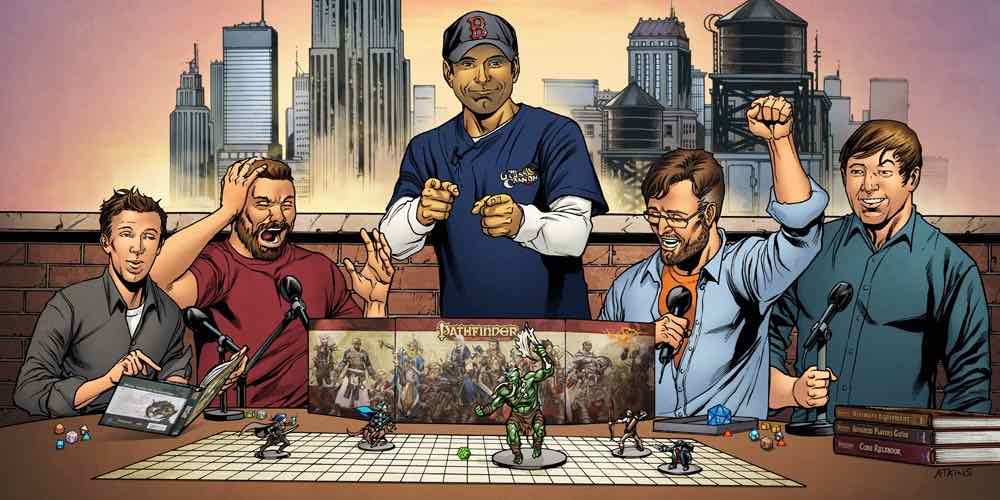

I really like the concept of this game. Even though she’s technically not in the age range, I think my 4 year old could enjoy this. Plus she loves those Haba gems. It started with Unicorn Glitterluck and continued with Dragon’s Breath. No doubt she’ll want to play this… to the point of lack of supervision.
By the way, Polygon has a great write-up on the development of this game a well as what goes into the development of children’s games. It’s worth a read. https://www.polygon.com/tabletop-games/22608427/bestselling-childrens-board-games-haba-yellow-boxes-child-psychologist-hammer-time
My 8-year-old will still pull games off the shelf and play with them by herself at times when other people aren’t available, and she definitely did that with other HABA titles when she was younger, too! I encouraged it because it let her figure things out and practice in between times when we played with her.
I’m fine with my 8 year old pulling out games on her own. My 4 year old, though, will break things, push things into other (non-game) things, and otherwise lose items if no one is looking out for her. Also appears to want to put things in her mouth again, so… I’m fine with exploration and remixing games, but I just have very specific concerns at the moment. 😅
Ah, yes, fair enough! Definitely if she’s putting things in her mouth, that could get risky. Good luck!